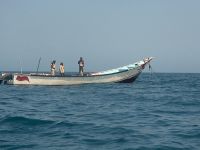Note: Information contained in this report is the best available as of August 2000 and can change.
GENERAL BACKGROUND
Tajikistan has the lowest per capita gross domestic product (GDP) in the former Soviet Union. A civil war between Islamic conservatives and the secular government lasted from 1992 through 1997.
Following a peace agreement between the United Tajik Opposition (UTO) and the government of President Emomali Rakhmonov in June 1997, however, a modest recovery has been underway.
Tajikistan concluded a loan agreement with the International Monetary Fund (IMF) shortly after the peace agreement. The country's real GDP grew 3.7 percent in 1999, and is projected to maintain modest real growth of around 3.0 percent in 2000.
Tajikistan's economy is concentrated in a small number of industries, mainly cotton, aluminum, and hydroelectricity. The Tursanzade aluminum smelting plant is the world's largest such facility.
OIL
Tajikistan produced approximately 3,500 barrels per day (bbl/d) of oil in 1999 (of which 3,000 was crude oil), and consumed a total of 29,000 bbl/d of petroleum products. Since Tajikistan does not have a domestic refinery, all petroleum products must be imported.
Other Commonwealth of Independent States (CIS) countries account for more than 97 percent of Tajikistan's oil product imports, with Uzbekistan supplying more than 7o percent.
Tajikistan held talks in June 2000 with Iranian officials about possible Iranian assistance for Tajikistan's oil sector.
NATURAL GAS
Tajikistan has natural gas reserves of only 200 billion cubic feet (Bcf), and only minor domestic production. Tajikistan thus relies heavily on imports of natural gas from neighboring Uzbekistan and Turkmenistan.
Pipelines run from Uzbekistan to Tajikistan's capital Dushanbe, and through northern Tajikistan. Total Tajik consumption of natural gas in 1998 was 40 Bcf. Uzbekistan has a barter arrangement with Tajik authorities under which gas is supplied in exchange for the use of a rail transport corridor and gas pipeline across northern Tajikistan. The agreement was renewed for another year in January 2000.
Tajikistan has reportedly conducted successful drilling for gas in 2000 in the southern Khatlon region. China has expressed interest in participation in future gas exploration in Tajikistan.
ELECTRIC POWER
Electric power in Tajikistan comes primarily from hydroelectric dams, which Tajikistan's mountainous terrain makes possible. Tajikistan's total electric generating capacity in 1998 was 4.4 gigawatts (GW). Tajikistan has two power grids, one in the southern part of the country and a separate grid in the northern Leninabad region, both with links to Uzbekistan.
Due to the fact that Tajikistan and Uzbekistan are intertwined geographically, the two export power to each other. Over the last decade, Tajikistan has been both a net exporter and net importer of electricity, depending on rainfall and its ability to produce hydropower.
According to press reports, Tajikistan is experiencing a serious electricity shortage in 2000, and has been forced to import more electricity and impose power cuts on residential customers. Electricity prices were raised in April 2000 to limit demand.
The largest consumer of electric power by far is the Tursunzoda aluminum plant, which alone currently consumes 40 percent of the entire electric power generation of Tajikistan.
A new hydroelectric power dam, Sangtuda, is under construction with Russian and Iranian financing. The project was started during the Soviet period but sat unfinished for lack of funding for several years. It is expected to eliminate Tajikistan's need for power imports in the north. A link between the northern and southern power grids is also planned. A study on improvements to the Tajik power grid, funded by Kuwaiti aid, is currently underway.
Sources for this report include: BBC Summary of World Broadcasts; CIA World Factbook 1999; Economist Intelligence Unit ViewsWire; Hart's Asian Petroleum News; Petroleum Intelligence Weekly; U.S. Energy Information Administration; WEFA Eurasia Economic Outlook.
COUNTRY OVERVIEW
President: Emomali Rakhmonov
Prime Minister: Oqil Oqilov
Independence: September 9, 1991 (from Soviet Union)
Population (1999E): 6.1 million
Location/Size: Central Asia/143,100 sq. miles, slightly smaller than Wisconsin
Major Cities: Dushanbe (capital)
Languages: Tajik (official), Russian
Ethnic Groups: Tajiks (64.9%), Uzbek (25%), Russian (3.5%), other (6.6%)
Religions: Sunni Muslim (80%), Shi'a Muslim (5%), other (15%)
ECONOMIC OVERVIEW
Currency: Tajik Ruble (TJR)
Commercial Exchange Rate (12/99): $1=1,436 TJR
Nominal Gross Domestic Product (1999E): $1.1 billion
Real GDP Growth Rate (1999E): 3.7% (2000E): 3.0%
Inflation Rate (1999E): 30.1%
Merchandise Exports (1999E): $689 million
Merchandise Imports (1999E): $664 million
Major Export Products: Cotton, aluminum, fruits
Major Import Products: Fuel, chemicals, machinery
ENERGY OVERVIEW
Proven Oil Reserves (1/1/00): 12 million barrels
Oil Production (1999E): 3,500 barrels per day (bbl/d)
Oil Consumption (1999E): 29,000 bbl/d
Natural Gas Reserves (1/1/00): 200 billion cubic feet (Bcf)
Natural Gas Consumption (1998E): 40 Bcf
Electric Generation Capacity (1998): 4.4 gigawatts
Electricity Production (1998E): 13.3 billion kilowatt hours (bkwh), of which 13.1 bkwh was from hydroelectric dams
Net Electricity Imports (1998E): 0.2 billion kWh
ENVIRONMENTAL OVERVIEW
Minister of Environmental Protection: Ismail Davlatov
Total Energy Consumption (1998E): 0.2 quadrillion Btu* (0.06 percent of world total energy consumption)
Energy-Related Carbon Emissions (1998E): 1.7 million metric tons of carbon (0.03 percent of world carbon emissions)
Per Capita Energy Consumption (1998E): 38.4 million Btu (vs. U.S. value of 350.7 million Btu)
Per Capita Carbon Emissions (1998E): 0.3 metric tons of carbon (vs. U.S. value of 5.5 metric tons of carbon)
Energy Intensity (1998E): 149,200 Btu/ $1990 (vs U.S. value of 13,400 Btu/ $1990)**
Carbon Intensity (1998E): 1.05 metric tons of carbon/thousand $1990 (vs U.S. value of 0.21 metric tons/thousand $1990)**
Sectoral Share of Energy Consumption (1997E): Industrial (58.2 percent), Transportation (33.0 percent ), Residential (10.2 percent)
Sectoral Share of Carbon Emissions (1997E): Transportation (84.4%), Industrial (13.3 percent), Residential (2.3 percent)
Fuel Share of Energy Consumption (1998E): Oil (23.2 percent), Natural Gas (17.2 percent), Coal (0.5 percent)
Fuel Share of Carbon Emissions (1998E): Oil (63.2%), Natural Gas (35.1%), Coal (1.7%)
Renewable Energy Consumption (1997E): 143 trillion Btu* (7 percent decrease from 1996)
Number of People per Motor Vehicle (1997): 1,000 (vs. U.S. value of 1.3)
Status in Climate Change Negotiations: Non-Annex I country under the United Nations Framework Convention on Climate Change (ratified January 7th, 1998). Not a signatory to the Kyoto Protocol.
Major Environmental Issues: Inadequate sanitation facilities; increasing levels of soil salinity; industrial pollution; excessive pesticides; part of the basin of the shrinking Aral Sea suffers from severe overutilization of available water for irrigation and associated pollution
Major International Environmental Agreements: A party to Conventions on Biodiversity, Climate Change, Desertification and Ozone Layer Protection
* The total energy consumption statistic includes petroleum, dry natural gas, coal, net hydro, nuclear, geothermal, solar and wind electric power. The renewable energy consumption statistic is based on International Energy Agency (IEA) data and includes hydropower, solar, wind, tide, geothermal, solid biomass and animal products, biomass gas and liquids, industrial and municipal wastes. Sectoral shares of energy consumption and carbon emissions are also based on IEA data.
**GDP based on EIA International Energy Annual 1998
OIL and GAS INDUSTRIES
Organization: Tajikistan produces extremely limited amounts of oil and natural gas. Exploration, drilling, and production is conducted by the Tajikneft company of Dushanbe.
Source: United States Energy Information Administration.
© 2000 Mena Report (www.menareport.com)







